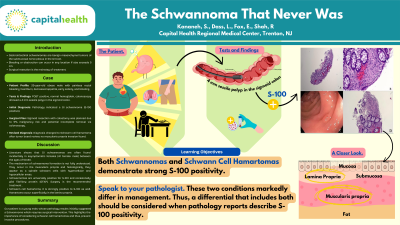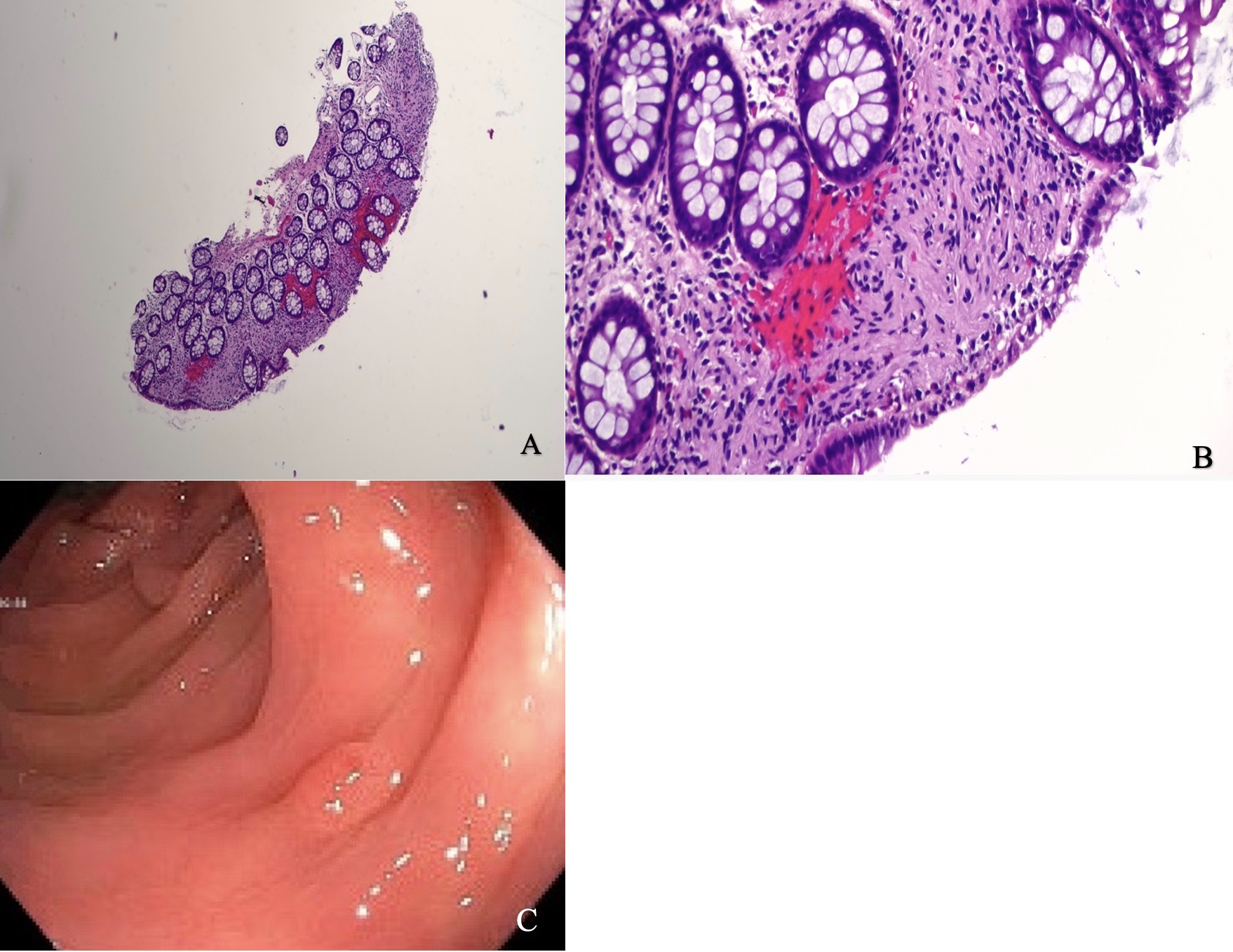Sunday Poster Session
Category: Colon
P0339 - The Schwannoma That Never Was
Sunday, October 27, 2024
3:30 PM - 7:00 PM ET
Location: Exhibit Hall E

Has Audio

Salman Kananeh, MBBS
Capital Health Regional Medical Center
Trenton, NJ
Presenting Author(s)
Salman Kananeh, MBBS1, Lucinda Dass, MD1, Ellen Fox, MD1, Ruchit Shah, DO2
1Capital Health Regional Medical Center, Trenton, NJ; 2Capital Health Gastroenterology, Bordentown, NJ
Introduction: Gastrointestinal schwannomas are benign mesenchymal tumors of the submucosal nerve plexus in the gastrointestinal (GI) tract. While often asymptomatic and incidentally found, symptoms may occur. Abdominal discomfort, dyspepsia, nausea, vomiting may occur in proximal locations such as the stomach, and bleeding or obstruction can occur in any location if size exceeds 5 cm. Stromal tumors are more common and carry more of a malignant potential. Surgical resection is the mainstay of treatment. Our case demonstrates a sigmoid colon schwannoma in a young male patient that eventually was revised to be a shcwann cell hamartoma. Which is another benign entity that requires less intervention.
Case Description/Methods: A 39-year-old male presented to the GI clinic with two episodes of painless rectal bleeding over three months. Associated symptoms included heartburn, decreased appetite, early satiety, and bloating over six months. He denied unintentional weight loss, dysphagia, nausea, or frequent NSAID use. Physical exam was unremarkable. FOBT was positive. Labs showed normal hemoglobin. Colonoscopy revealed a 4 mm sessile polyp in the sigmoid colon, resected with cold snare. Pathology results for the sessile polyp showed positivity to S-100, confirming the diagnosis of GI schwannoma initially. The patient was referred to surgery, and given the 5% risk of malignancy and possibility of incomplete removal, sigmoid resection with colostomy was planned. Our pathologist revised the diagnosis after tumor board and no invasion of the muscularis propria was found. Schwann cell hamartoma was diagnosed.
Discussion: Literature shows that GI schwannomas are often found incidentally in asymptomatic females (4:1 female: male) between the ages of 50-80. The mechanism of schwannoma formation is not fully understood. They occur in the muscularis propria and histologically, they appear as a spindle schwann cells with hypercellular and hypocellular areas. Nuclear atypia and mitotic activities may be present. Schwannomas are universally positive for S-100 and occasionally glial fibrillary protein (GFAP). Surgery is the recommended treatment. For Schwann cell hamartoma, it is strongly positive to S-100 as well. Hamartoma occur superficially in the lamina propria. Our patient is a young male, whose pathology results initially suggested a Schwannoma which requires surgical intervention. This highlights the importance of considering schwann cell hamartomas as an entity and thus, prevent invasive procedures.

Disclosures:
Salman Kananeh, MBBS1, Lucinda Dass, MD1, Ellen Fox, MD1, Ruchit Shah, DO2. P0339 - The Schwannoma That Never Was, ACG 2024 Annual Scientific Meeting Abstracts. Philadelphia, PA: American College of Gastroenterology.
1Capital Health Regional Medical Center, Trenton, NJ; 2Capital Health Gastroenterology, Bordentown, NJ
Introduction: Gastrointestinal schwannomas are benign mesenchymal tumors of the submucosal nerve plexus in the gastrointestinal (GI) tract. While often asymptomatic and incidentally found, symptoms may occur. Abdominal discomfort, dyspepsia, nausea, vomiting may occur in proximal locations such as the stomach, and bleeding or obstruction can occur in any location if size exceeds 5 cm. Stromal tumors are more common and carry more of a malignant potential. Surgical resection is the mainstay of treatment. Our case demonstrates a sigmoid colon schwannoma in a young male patient that eventually was revised to be a shcwann cell hamartoma. Which is another benign entity that requires less intervention.
Case Description/Methods: A 39-year-old male presented to the GI clinic with two episodes of painless rectal bleeding over three months. Associated symptoms included heartburn, decreased appetite, early satiety, and bloating over six months. He denied unintentional weight loss, dysphagia, nausea, or frequent NSAID use. Physical exam was unremarkable. FOBT was positive. Labs showed normal hemoglobin. Colonoscopy revealed a 4 mm sessile polyp in the sigmoid colon, resected with cold snare. Pathology results for the sessile polyp showed positivity to S-100, confirming the diagnosis of GI schwannoma initially. The patient was referred to surgery, and given the 5% risk of malignancy and possibility of incomplete removal, sigmoid resection with colostomy was planned. Our pathologist revised the diagnosis after tumor board and no invasion of the muscularis propria was found. Schwann cell hamartoma was diagnosed.
Discussion: Literature shows that GI schwannomas are often found incidentally in asymptomatic females (4:1 female: male) between the ages of 50-80. The mechanism of schwannoma formation is not fully understood. They occur in the muscularis propria and histologically, they appear as a spindle schwann cells with hypercellular and hypocellular areas. Nuclear atypia and mitotic activities may be present. Schwannomas are universally positive for S-100 and occasionally glial fibrillary protein (GFAP). Surgery is the recommended treatment. For Schwann cell hamartoma, it is strongly positive to S-100 as well. Hamartoma occur superficially in the lamina propria. Our patient is a young male, whose pathology results initially suggested a Schwannoma which requires surgical intervention. This highlights the importance of considering schwann cell hamartomas as an entity and thus, prevent invasive procedures.

Figure: A. Mucosal spindle cell proliferation, low power view
B. Lamina propria with spindle cells showing bland elongated nuclei, high power view
C. Sigmoid colon with superficial sessile polyp.
B. Lamina propria with spindle cells showing bland elongated nuclei, high power view
C. Sigmoid colon with superficial sessile polyp.
Disclosures:
Salman Kananeh indicated no relevant financial relationships.
Lucinda Dass indicated no relevant financial relationships.
Ellen Fox indicated no relevant financial relationships.
Ruchit Shah indicated no relevant financial relationships.
Salman Kananeh, MBBS1, Lucinda Dass, MD1, Ellen Fox, MD1, Ruchit Shah, DO2. P0339 - The Schwannoma That Never Was, ACG 2024 Annual Scientific Meeting Abstracts. Philadelphia, PA: American College of Gastroenterology.
